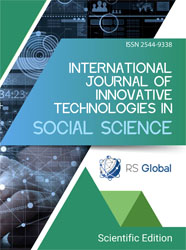RELIGIOUS REFERENCE FOR ARTISTIC CREATIVITY IN THE CIVILIZATIONS OF THE ANCIENT EAST (THE CIVILIZATION OF MESOPOTAMIA AS A MODEL)
Abstract
This research paper aims to highlight the presence of both "religion" and "art" in shaping the general civilizational framework of Mesopotamia and to explore the nature of the relationship between them through the material legacy left to us by the Mesopotamian civilization in these two vast knowledge fields.
"Religion," in all its aspects and components, occupied a prominent place in the lives of the peoples of Mesopotamian civilization, as it provided solutions to many of the problems threatening the existence and security of the human beings in this civilization. Thinkers of this civilization turned to religion to ensure security in all its forms in various areas of life. These religious beliefs were physically manifested in artistic forms, making "religion" a fundamental reference in shaping artistic work.
References
Khalid Fouad Taha, In the Philosophy of History, Dar Al-Arabia for Sciences Publishers, 1st Edition, Beirut (Lebanon), 2009, pp. 35-34.
Jamil Saliba, The Philosophical Dictionary, Vol. 1, Dar Al-Kitab Al-Lubnani, Beirut (Lebanon), (n.d.), 1982, p. 572.
Jamil Saliba, The Philosophical Dictionary, Vol. 2, Dar Al-Kitab Al-Lubnani, Beirut (Lebanon), (n.d.), 1982, p. 165.
Abdul Qader Fidoh, Aesthetic Experience in Arab Thought, Dar Al-Shajara for Publishing and Distribution, 1st Edition, Damascus (Syria), 2014, p. 39.
Taha Baqir, Introduction to the Literature of Ancient Iraq, Dar Al-Horiya for Printing, (n.d.), Baghdad (Iraq), 1976, p. 200.
Sabatino Moscati, The Ancient Semitic Civilizations, Translated by: Said Yaacoub Bakar, Reviewed by: Mohammed Al-Qassas, Dar Al-Katib Al-Arabi for Printing and Publishing, (n.d.), Beirut (Lebanon), 1986, p. 74.
Abdul Qader Fidoh, Op. cit., pp. 38-39.
Sabatino Moscati, Op. cit., p. 75.
L. Delaporte, Mesopotamia (The Babylonian and Assyrian Civilizations), Translated by: Muharram Kamal, Egyptian General Book Authority, 2nd Edition, Cairo (Egypt), 1998, p. 138.
Samuel Noah Kramer, From the Tablets of Sumer, Translated by: Taha Baqir, Al-Mutanabbi Library (Baghdad) and Al-Khanji Foundation (Cairo), (n.d.), (n.s.), pp. 155-154.
Sabatino Moscati, Op. cit., p. 75.
Samuel Noah Kramer, Op. cit., p. 155.
Abdul Razzaq Rahim Sallah Al-Mohi, Religions in Ancient Religions, Dar Safat for Studies and Publishing, 1st Edition, Damascus (Syria), 2012, p. 25.
Fawzi Rashed et al., The Civilization of Iraq, Vol. 1, Dar Al-Horiya for Printing, (n.d.), Baghdad (Iraq), 1985, p. 146.
Taha Baqir, Introduction to the Literature of Ancient Iraq, p. 72.
Nazla Al-Jubouri, The Philosophy of Unity of Existence in Islamic Thought, Dar Ninawa for Studies, Publishing and Distribution, (n.d.), Damascus (Syria), 2009, pp. 43-42.
Taha Baqir, Op. cit., p. 73.
Taha Baqir, Introduction to the Literature of Ancient Iraq, pp. 70-69.
L. Delaporte, Mesopotamia (The Babylonian and Assyrian Civilizations), p. 140.
Same source, p. 140.
Fawzi Rashed et al., The Civilization of Iraq, Vol. 1, p. 155.
L. Delaporte, Op. cit., p. 142.
Fawzi Rashed et al., The Civilization of Iraq, Vol. 1, pp. 160-161.
L. Delaporte, Mesopotamia (The Babylonian and Assyrian Civilizations), pp. 143-144.
Fawzi Rashed et al., Op. cit., pp. 164-163.
Samuel Noah Kramer, From the Tablets of Sumer, pp. 156-155.
Fawzi Rashed et al., The Civilization of Iraq, Vol. 1, p. 182.
L. Delaporte, Mesopotamia (The Babylonian and Assyrian Civilizations), p. 146.
Fawzi Rashed et al., Op. cit., p. 183.
Same source, pp. 148-149.
Abdul Razzaq Rahim Sallah Al-Mohi, Religions in Ancient Religions, p. 26.
Fawzi Rashed et al., Op. cit., pp. 185-189.
L. Delaporte, Mesopotamia (The Babylonian and Assyrian Civilizations), p. 147.
Sabatino Moscati, The Ancient Semitic Civilizations, p. 77.
Sabatino Moscati, The Ancient Semitic Civilizations, pp. 76-78.
Abdul Razzaq Rahim Sallah Al-Mohi, Religions in Ancient Religions, p. 26.
Fawzi Rashed et al., The Civilization of Iraq, Vol. 1, p. 190.
L. Delaporte, Mesopotamia (The Babylonian and Assyrian Civilizations), p. 158.
Fawzi Rashed et al., Op. cit., pp. 190-195.
L. Delaporte, Op. cit., p. 163.
Abdul Razzaq Rahim Sallah Al-Mohi, Religions in Ancient Religions, p. 27.
Fawzi Rashed et al., The Civilization of Iraq, Vol. 1, pp. 177-179.
Sabatino Moscati, The Ancient Semitic Civilizations, p. 79.
L. Delaporte, Mesopotamia (The Babylonian and Assyrian Civilizations), pp. 154-160.
Taha Baqir, Introduction to the Literature of Ancient Iraq, pp. 83-82.
L. Delaporte, Mesopotamia (The Babylonian and Assyrian Civilizations), pp. 161-160.
Fawzi Rashed et al., The Civilization of Iraq, Vol. 1, pp. 165-164.
L. Delaporte, Op. cit., p. 160.
Taha Baqir, Introduction to the Literature of Ancient Iraq, pp. 83-82.
Sabetino Moscati, The Ancient Semitic Civilizations, p. 106.
Margaret Ruthen, The History of Babylon, Translated by: Zeina Azar and Michel Abu Fadel, Awadit Publications, 2nd Edition, Beirut (Lebanon), 1984, p. 102.
L. Delaporte, Mesopotamia (The Babylonian and Assyrian Civilizations), p. 173.
Margaret Ruthen, Op. cit., p. 95.
Walid Al-Jader et al., The Civilization of Iraq, Vol. 2, p. 239.
L. Delaporte, Mesopotamia (The Babylonian and Assyrian Civilizations), pp. 178-185.
Sabatino Moscati, The Ancient Semitic Civilizations, p. 112.
Taqi Al-Dabbagh et al., The Civilization of Iraq, Vol. 3, pp. 8-7.
L. Delaporte, Op. cit., pp. 187-191.
L. Delaporte, Mesopotamia (The Babylonian and Assyrian Civilizations), pp. 194-196.
Said Ismail Ali, Education in Ancient Eastern Civilizations, World of Books, (n.d.), Cairo (Egypt), 1999, p. 149.
L. Delaporte, Op. cit., p. 196.
Said Ismail Ali, Education in Ancient Eastern Civilizations, p. 148.
Sabetino Moscati, Op. cit., p. 106
Views:
58
Downloads:
55
Copyright (c) 2025 Mohamed El Abed Hachelouf

This work is licensed under a Creative Commons Attribution 4.0 International License.
All articles are published in open-access and licensed under a Creative Commons Attribution 4.0 International License (CC BY 4.0). Hence, authors retain copyright to the content of the articles.
CC BY 4.0 License allows content to be copied, adapted, displayed, distributed, re-published or otherwise re-used for any purpose including for adaptation and commercial use provided the content is attributed.











